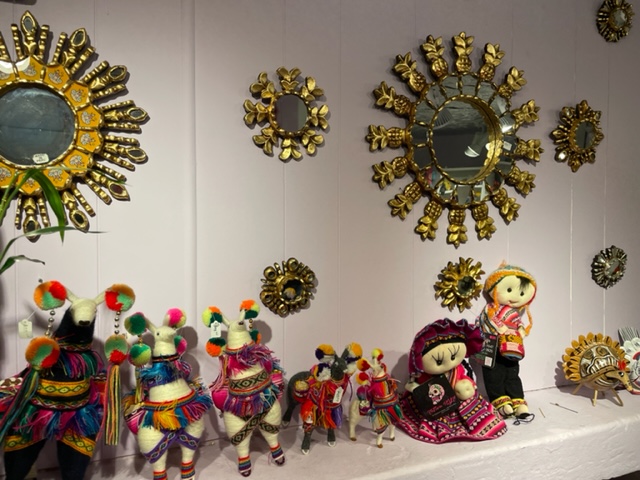While walking down Henry St., I noticed a shop called Catrina NYC with colorful jewelry and t-shirts outside the front door. Looking through the window, I could see there was more jewelry, artwork, dolls, toys, textiles, and much more.
After going inside, I was greeted by Karina Perez and her dog, a dachshund named Caramelo. Perez was kind enough to tell me about her shop and her own journey to Cobble Hill.
“I was actually born here in New York but when I was one and a half years old I moved to Oaxaca, Mexico and I lived there for 20 years,” Perez said. “I always knew I wanted to come back since I have family here in New York including my father. I also knew there were more opportunities here. My mom is in Mexico and I always go back to visit every year.”
Perez makes some of the smaller items in the shop like keychains and bracelets but the rest are made by indigenous people from Mexico, Peru, Ecuador, Colombia, El Salvador, and Guatemala.
“I have a lot of things from Oaxaca since I met a big community of artists when I was growing up there,” Perez said. “I’ve also traveled to other countries and people tell me this is ‘my artwork and I’m making it to support my family.’ When I think the art is good, I can begin negotiations with the artists.
Helping artists back home
“Whenever people stop in and buy things, it isn’t just important for me, but also for all of the people who are supporting their families by making the art. The biggest challenge I face is when it’s not so busy. A lot of the local people go away on vacations, especially in the summer but thankfully there are also tourists who visit here and they stop in and buy some things. The winter can also be tough with the cold weather and fewer people going outside, and February was a tough month. I’ve been here for a year now so I think more people are getting to know about the store, which helps.”
Perez also spoke about her appreciation for her customers and the neighborhood, saying “There are a lot of kind people who come in, and everybody likes something different. Five people say they love the hummingbirds, then five people say they love the dresses, and in the summer a lot of people like the hats.”
A few of her own favorites include the toys and the textiles because of how unique they are. Additionally, when making some of the toys, including some of the dolls, mothers, fathers, and children work together to make them, with each family member having his or her own job in the process.
Perez also explained the long and sometimes difficult process to make the different pieces including small sculpted animals and Day of the Dead skulls, saying “First they make little pieces and get the shapes right. Then they paint in layers, adding a lot of details, and then they add glitter to them.” Other pieces, including the hummingbirds, are made by hand with beads. Others are made by burning wood, “and the process is really beautiful. Watching it is like watching magic, and everything takes a long time because they have to be very precise.”
In addition to teaching me a lot about the items in Catrina NYC, Perez said that she hopes other customers will be able to learn about the cultural origins of various pieces of art.
One of Perez’s favorite things about her work is that she is able to have her dog, Caramelo with her.
“He is 11 months old, and he’s my baby,” Perez said. “He’s from Oaxaca, Mexico, and he has two brothers. One is in Mexico with my mom and the other one is with my cousin who lives in Queens.”
Perez hopes more people will hear about Catrina NYC, stop by, and help spread the word since the store is still fairly new. There are a lot of beautiful pieces of art as well as clothing and I think it is a good place to go when buying a gift.
“I’m really happy to be here,” Perez said. “I want to keep having unique art, and continue supporting the artists who make the beautiful pieces that are here at Catrina NYC.”
Catrina NYC, 331 Henry Street, Brooklyn, NY (929) 644-2171
Author
Discover more from Red Hook Star-Revue
Subscribe to get the latest posts sent to your email.










